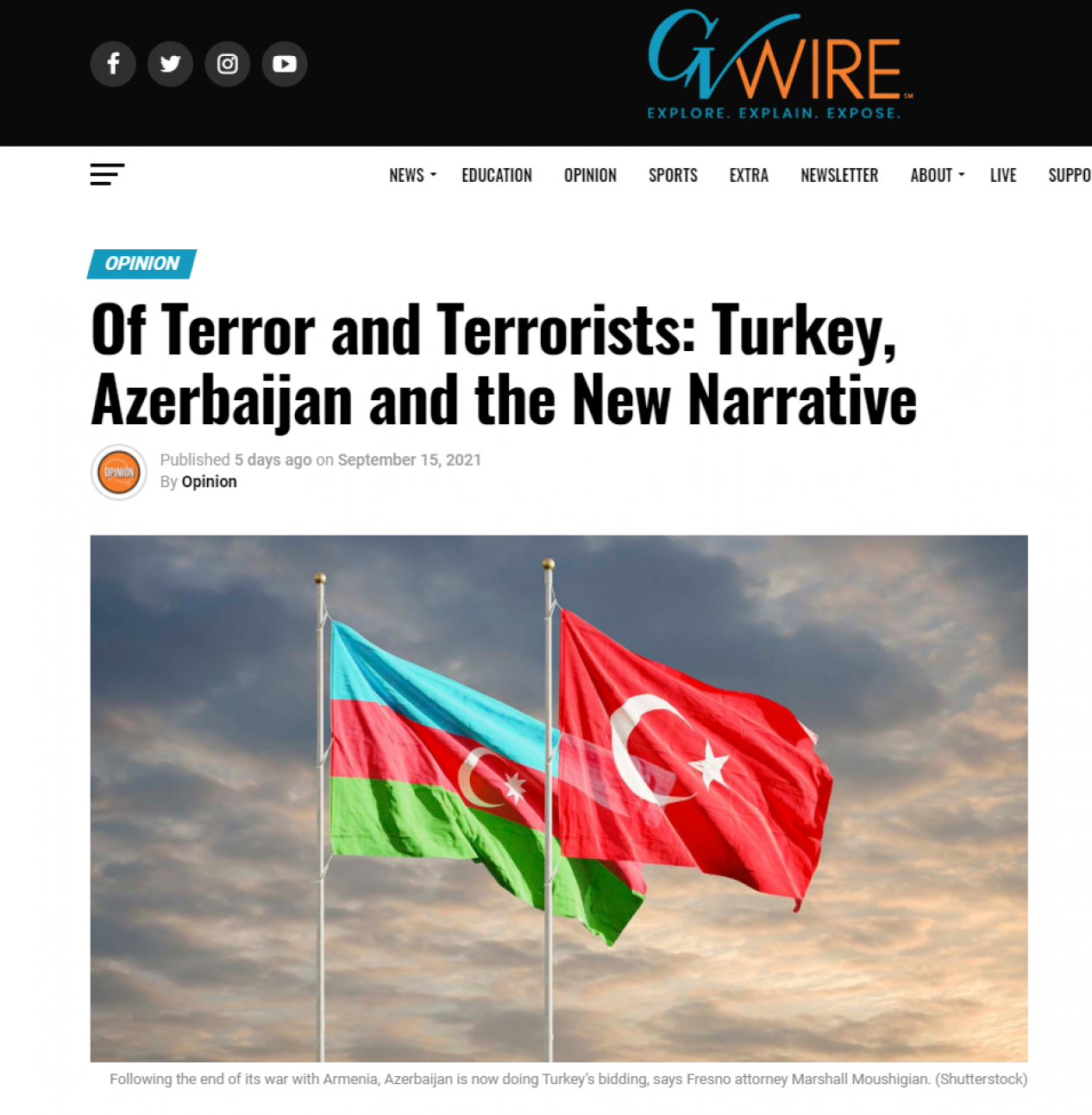
Recently, the American publication GV Wire, the editorial office of which is located in the California city of Fresno, has published an article by attorney and financial adviser Marshall Moushigian entitled “Of Terror and Terrorists: Turkey, Azerbaijan and the New Narrative.” The author, in particular, writes that “with Turkey’s help, Azerbaijan imported Islamic jihadist terrorists to fight against the Christian Armenians.” Without citing facts, Moushigian claims that “during the invasion, the Azeri military targeted schools, maternity hospitals, residential neighborhoods, churches and other civilian targets with suicide drones and banned cluster bombs.” In his opinion, Armenians continue to become victims of violence and racism: “Despite a ceasefire and following the blueprints of Turkey and ISIS, destroying Armenian churches and culture in Artsakh [Karabakh].”
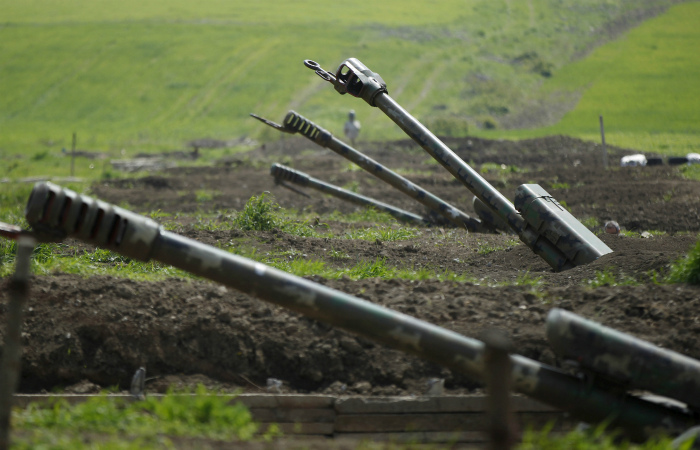
There is a significant Armenian community in the city of Fresno, which is located in the Central Valley. The article itself is a reflection of the opinions existing in the large Armenian diaspora, and through such fake news, an attempt is made to spread a one-sided assessment of the Karabakh conflict among other groups of the US population.
Faktyoxla Lab. has tried to figure out how plausible the statements of the Armenian author of GV Wire are, and whether it is possible to trust such publications of the Armenian side.
Let’s start with the statement that “during the invasion, the Azeri military targeted schools, maternity hospitals, residential neighborhoods, churches and other civilian targets.”

From the very beginning of hostilities, the Azerbaijani side had repeatedly stated that it didn’t strike at civilian objects and civilians. On the very first day of the Second Karabakh War on Sept. 27, 2020, the Azerbaijani Ministry of Defense announced that the Azerbaijani army was not striking civilians and civilian infrastructure. The statement also said that the Armenian army deliberately places its firing points within and near settlements. For this reason, the leadership of the Azerbaijani army called on the Armenian civilian population in the occupied territories to stay away from military objects. In other statements made during the war, the Azerbaijani Defense Ministry had repeatedly stressed that the Azerbaijani army fired only at military targets, and not at civilians, complied with the requirements of the provisions of international humanitarian law during military operations, including the Geneva Conventions.
However, Armenian sources and their associates, from the very beginning of the 44-day war, massively disseminated news about shelling of civilian objects. For example, news about the shelling of Khankendi appeared several times, among which the most “impressive” were reports of the destruction of a maternity hospital. At the same time, they vaguely spoke about the “multitude of victims.” After a while, the authors clarified that the blow fell not on the hospital itself, but next to it. But soon, in the Armenian media there were “clarifications” that the city was allegedly bombed by F-16 fighters of the Turkish Air Force.
Firstly, even online flight trackers like Flightradar didn’t record such violations as Turkey’s direct participation in the Armenian-Azerbaijani conflict. Moreover, there was no air raid at all, and no one was injured in the maternity hospital, since it has been empty for some time. The latter fact was confirmed by the Associated Press. The report says that only the premises adjacent to the hospital were damaged, and the incident did not result in casualties. The agency also notes that as a result of the shelling of the Azerbaijani city of Barda, more than 20 civilians were killed and over 70 injured. The Azerbaijani Defense Ministry, through its official telegram channel, denied the accusation of the Armenian side. The ministry said that the reports of the Armenian media about the alleged shelling of the maternity hospital in Khankendi by the Azerbaijani armed forces are ‘deliberately replicated disinformation,’ with the help of which Yerevan is trying to divert attention from its war crimes.
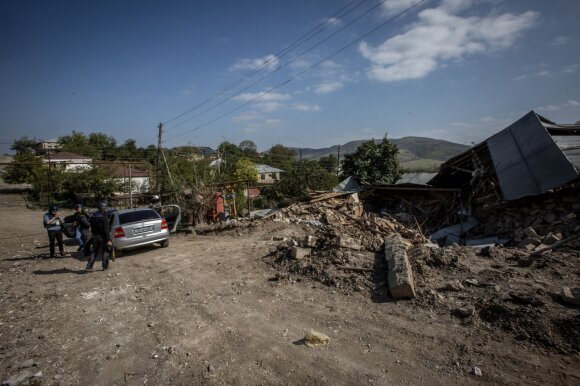
Secondly, in the course of the war, sufficient evidence appeared in the information field showing how the Armenian side used civilian objects for military purposes. For example, the Armenians used for military purposes a secondary school in the village of Girmizi Bazar (Red Bazaar) of the Khojavend region (it was occupied on October 2, 1992 by the Armenian Armed Forces and renamed Karamir Shuka, which also means Red Bazaar in Armenian). This is confirmed by the video of another strike on the military units of the Armenian army, distributed by the Armed Forces of Azerbaijan. It also shows the Armenian military delivering ammunition by car to the school building. The Azerbaijani Defense Ministry stated that the Armenian Armed Forces used the school building as a headquarters. In addition, this map shows the kindergarten building located near the school. During the war, there was also a report about the meeting of the head of the separatist ‘regime’ Arayik Harutyunyan with the military in the premises of the kindergarten. This is evidenced by the photos that he shared on his Facebook page on October 25, 2020.
The facts confirming the use of such methods by the Armenians were revealed by the photojournalist of the website delfi.ru Vidmantas Balkunas, who prepared a series of reports from Khankendi and Shusha. In his article published on the website on October 21, he emphasizes the use of the shelter by the Armenian military, where civilians are staying. He also notes such facts as the placement of rocket launchers in the city park, the storage of ammunition in the House of Culture, the deployment of the S-300 air defense system near a residential village.
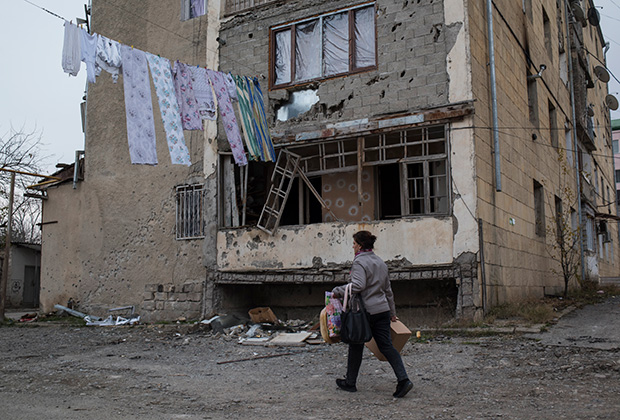
Let’s take another example. The Spanish journalist Pablo Gonzalez, who covered the 44-day Second Karabakh from the Armenian side of the front line, shared with the Russian website lenta.ru his impressions and recollections of the hardships and various events of those days. In particular, he said that the Azerbaijani side didn’t aim to fire at civilian objects, hotels and densely populated areas in Khankendi. He noted that the Azerbaijani army didn’t even strike at the building where the so-called presidential administration of the separatists was located, although it could well had done so. The journalist said that the city of Mardakert (Agdere) was bombed by Su-25 attack aircraft of the Azerbaijani Air Force, and named the reason for this. He added that everyone knew that Armenian artillery was deployed in the city, which fired on the Azerbaijani side. He said that for this reason, the Azerbaijanis fired at these targets.
Another example is when the Armenian media reported that on October 4 last year, the Azerbaijani army destroyed a building in Shusha, and also published photos of the ruins of a House of Culture. The reports said that the Azerbaijani side was purposefully shelling the settlements of Nagorno-Karabakh. Two days after the October 6 incident, Izvestia.ru, citing local residents, reported that during the shelling, civilians were in the basement of the building, and children were in the neighboring streets. Several people were injured as a result of the explosion. One of the local Armenians said that a children’s choir ensemble was rehearsing and performing at the club. The Armenians tried to pass off the destruction of the Shusha House of Culture as the result of the shelling of a civilian object by the Azerbaijani Armed Forces, but a few days later another thing turned out. On October 7, Ilya Azar, an employee of the Russian newspaper Novaya Gazeta, in his report from Shusha and Lachin noted that the building was actually used by the military. After this publication, the Armenian Foreign Ministry revoked the accreditation of Ilya Azar, an employee of Novaya Gazeta.
The Azerbaijani army destroyed the S-300 anti-aircraft missile system of the Armenian air defense in the village of Shushakend in Khojaly district during the war. There were other reports of similar cases.
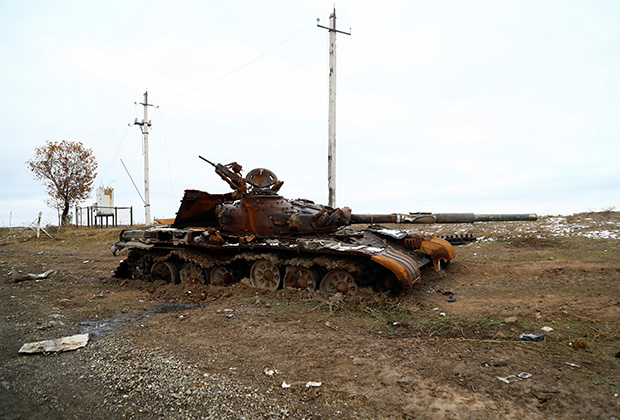
It can be assumed that the use of civilian objects such as schools, kindergartens and churches for military purposes was deliberate in order to subsequently blame Azerbaijan for the destruction of civilian objects.
Thirdly, let’s note that ‘the Middle East mercenaries fighting in Karabakh on the side of Azerbaijan’ became a recognizable narrative of the Second Karabakh War, invariably accompanying it in the information field. Azerbaijan has repeatedly officially denied such reports, citing weighty arguments: having an army of several thousand people and a significant mobilization reserve, the country doesn’t need mercenaries, and even more so radical jihadists who threaten its statehood, stability and security.
Another favorite technique of the authors of such fake news was ‘Syrian militants’ in the form of Azerbaijani border troops. The trick with the uniform of the Azerbaijani border guard was used repeatedly and was exposed. Messages of this kind are abundant online. The evidential basis used in most cases is either messenger correspondence with the alleged mercenaries, social media posts, or information disseminated by the UK-based Syrian Observatory for Human Rights (SOHR). Naturally, in this situation, the question arose about the biased coverage of events.
Thus, taking into account the above-mentioned facts, it is safe to say that the statements of the GV Wire are unfounded and false.




















